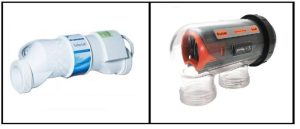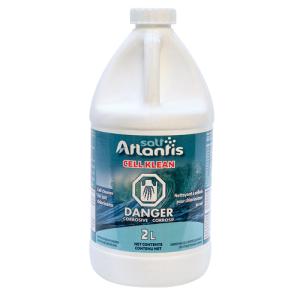WATER PROBLEM SOLUTIONS
Introduction
RBF presents solutions for pool and spa water problems. Simply select a problem from the list below to obtain the precise solution and a recommendation of the products to use to correct the situation.
Tips and tricks
Swimming Pool
We recommend cleaning the filter sand at least once a year. The ideal time to do this is when the pool is opened in spring. Backwashing helps to clean the filter. However, there is an easy-to-use product that’s ideal for getting the swimming season off to a good start with clean sand. Sand Filter Cleaner dislodges grease and dirt embedded in the filter’s sand grains. This highly effective product will also extend the life of the filter sand.
View pool maintenance schedule
There’s an alternative to liquid pool clarifiers. Innovation creates pre-measured dosage products that make our daily lives easier. A pre-measured clarifier stick is now available for swimming pools. It’s far more effective and easier to use than liquid clarifiers. Just one sachet per week in the skimmer is enough for pools with less than 75,000 L of water, and 2 sachets for pools with more than 75,000 L.
When the ice melts in spring, it’s a shame to see the liner, steps or water returns completely stained. Possible causes are stagnant winter water, leaf stains or even the presence of metals in the water. You’ll be pleased to know that there’s an easy-to-use product that cleans all stained parts of your pool. Stain Remover is specially designed to remove all types of stains immediately on application. Simply spread it over the area in question and you’re done. This product is also effective on stained spas.
On sunny days, the sun’s UV rays cause the pool’s chlorine to evaporate! Stabilizer is the solution. Once dissolved in your pool water, this product prevents chlorine from being destroyed by UV rays. We therefore recommend that you place this product in the skimmer as soon as you open the pool. What’s more, using stabilizer can reduce chlorine consumption by up to 40% over the summer.
View pool maintenance schedule
There are two types of algicide! Most ordinary algaecides, concentrated at 5%, 10% or 15%, act only as a preventive measure. They won’t destroy the algae in your pool water. Other algaecides, such as those with 40% and 60% concentrations, not only destroy algae, but also prevent their formation. Weekly use of 40% or 60% algicide killers will ensure crystal-clear, algae-free pool water.
90% of the chlorine added to pool water is used to oxidize impurities, while only 10% is used to disinfect the water. With a chlorine-free shock-treatment oxidizer, used every other week, the main function of the chlorine in the pool water will be to disinfect. What’s more, this product will reduce chlorine consumption by 50-75% over the entire season, leaving the pool water crystal-clear and sparkling.
View pool maintenance schedule
Spa
Chlorine-free shock treatment for spas performs the oxidation task, leaving the chlorine to do the disinfecting work. Simply use 1 sachet per week for optimum water clarity. Chlorine-free shock treatment for spas is often known as Oxi-Shock and comes in an easy-to-use, pre-measured 40 g sachet.
View spa maintenance schedule
FAQ
In general, here’s what the cell of a salt water system on the Quebec market looks like. The cell casing is made of plastic, and the inside of the cell is made of titanium plates. Two companies dominate the market: Hayward and Astral.

One of the most important things to remember for all salt pool owners is to clean the cell, which should be cleaned with a cell cleaner. This will extend the life of the cell and avoid having to replace it after only a few years.

- Firstly, add pool salt to the saltwater pool (between 3 kg and 4 kg per 1000 L of water depending on the system).
- The saltwater then passes through the cell which contains titanium plates.
- Electrolysis occurs between the titanium plates due to a low electric current transmitted by the control box.
- This electrolysis breaks the salt molecule (NaCl*) into two, creating chlorine in the pool. Cl* in the chemical formulation stands for Free Chlorine.
- Once the disinfection process is completed, the chlorine turns back into salt.
- The salt never runs out and does not evaporate. The only possible loss of salt occurs through backwashing or water splashing.
Chlorine-Free Shock Treatment | Chlorinated Shock Treatment |
|---|---|
| Eliminates combined chlorine (chloramines and odors). | Eliminates algae. |
| Clarifies cloudy water. | Clarifies cloudy water. |
| Resistant to the sun’s ultraviolet rays. | Not resistant to the sun’s ultraviolet rays (evaporates). |
| Swimming is possible immediately after treatment. | Swimming possible 24 hours after treatment. |
| Does not affect pH levels. | Increases pH levels. |
| For optimal effectiveness, a chlorine level between 1 and 3 ppm is required. | Provides a chlorine reserve. |
| Note: Chlorine-free shock treatment is not a disinfectant. It is important to combine it with chlorine to ensure water disinfection. |
Chlorine-Free Shock Treatment | Chlorinated Shock Treatment |
|---|---|
| When there are strong chlorine odors. | In the presence of cloudy water. |
| In case of eye and skin irritation. | After heavy rain. |
| During periods of heavy use or very sunny days. | In the presence of algae or if your pool liner is slippery (early algae formation). |
Lithium | Bromine |
|---|---|
| 35% chlorine concentration. | 30% chlorine concentration. |
| Granular product that immediately provides a dose of chlorine. | Slow-dissolving tablet product that gradually provides chlorine. |
| Perfect when we have time to take care of the spa. | Perfect when we do not have time to take care of the spa. For example: at the cottage. |
| This product increases pH. | This product decreases pH. |
| This product does not affect alkalinity. | This product affects alkalinity. |
| The effectiveness of lithium is dependent on pH. | The effectiveness of bromine is not dependent on pH. |
| Produces chloramines (harmful). | Does not produce chloramines. |
Therefore, it is important to understand that in reality, one product is not better than the other. Essentially, both products disinfect and oxidize contaminants.
The choice thus comes down to the consumer, according to their preference.
If you’re using lithium and want to switch to bromine, there’s no problem. Just stop using lithium and switch to bromine. It’s that simple. However, if you’re using bromine and want to switch to lithium, you must first drain your spa completely. Otherwise, the lithium you use will change to bromine. Why should this happen? Simply a question of chemistry.
Contrary to popular belief, a high chlorine level will not irritate the eyes. Only two factors are responsible for these irritations:
- The **presence of chloramines** (combined chlorine)
- An **improperly adjusted pH**
The use of a **chlorine-free shock treatment (Oxy) will eliminate chloramines**. Since the pH of your eyes is 7.5, water with a pH different from that of your eyes will automatically irritate them. That’s why it’s so important to **maintain the pH level** of your pool **between 7.2 and 7.8**.
The sun’s ultraviolet rays effectively eliminate the free chlorine in your pool water on hot sunny days. Adding stabilizer will help prevent the sun’s ultraviolet rays from destroying the free chlorine in your pool water.
It’s important to keep stabilizer levels between 30 and 50 ppm. This product should only be used by users of granulated chlorine (calcium hypochlorite) or in pools equipped with a salt chlorinator.
The filter sand should be cleaned once a year, either at the beginning or end of the season. To do this, use a sand filter cleaner.
The use of this product will extend the life of the filter sand and prevent future filtration problems with the pool.
Cloudy water can be caused by various improperly adjusted parameters. Check the following points:
- If the pH is too high (above 7.8), readjust it downwards with **pH-**.
- If the level of free chlorine is less than 1 ppm, increase it to a maximum of 3 ppm.
- If the sand in your filter hasn’t been cleaned in the past year, clean it with a **sand filter cleaner**.
- If all the previous parameters are properly adjusted, add a **clarifier in sticks or liquid**.
If algae starts to appear, it’s likely that your pool water has run out of chlorine. To get rid of algae effectively, add a shock treatment with chlorine and a destructive algaecide.
Wait 3 hours and then brush the walls and bottom of the pool. Wait 12 hours and vacuum up any dead algae at the bottom of the pool. Then backwash.
Note: If your pool liner is slippery, this is a sign that algae are beginning to form.
- If the pH of your pool is consistently too high, it’s likely because you’re using a chlorine product with a high pH level (granular chlorine). Adjust the pH by adding pH- to maintain the pH level between 7.2 and 7.8.
- If the pH of your pool is consistently too low, it’s probably because you’re using a chlorine product with a low pH level (stabilized chlorine tablets). Adjust the pH by adding pH+ to maintain the pH level between 7.2 and 7.8.
- If the pH fluctuates up or down and it’s difficult to maintain between 7.2 and 7.8, make sure to check the total alkalinity level of the pool water and maintain it between 80 and 120 ppm.
We recommend adding chlorine at the end of the day, once the sun has gone down and there are no more bathers in the pool.
If your pool is equipped with a chlorinator, you should use stabilized chlorine tablets.
If your pool is not equipped with a chlorinator, you can use either granulated chlorine or chlorine tablets, both of which are equally effective.
An opening kit is the simplest and most effective way to open your pool at the start of the season. However, if your pool water is black or dark green, with a heavy accumulation of leaves on the bottom, the addition of a 40% or 60% algaecide is recommended.
